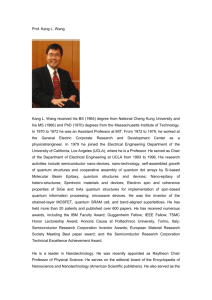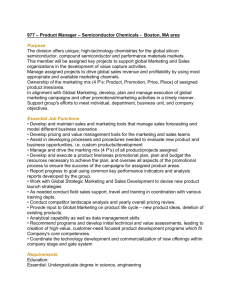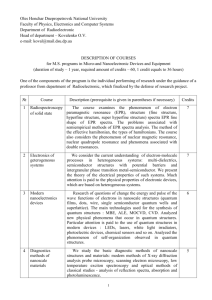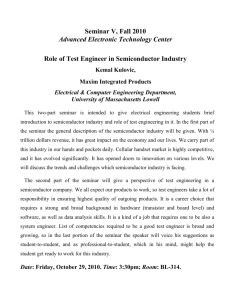Lecture-7-8 - Dr. Imtiaz Hussain
advertisement
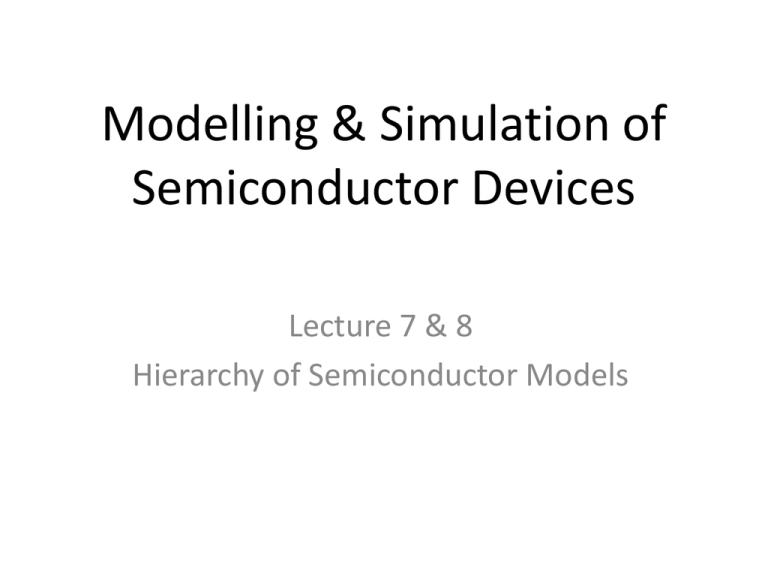
Modelling & Simulation of Semiconductor Devices Lecture 7 & 8 Hierarchy of Semiconductor Models Introduction • Nowadays, semiconductor materials are contained in almost all electronic de-vices. • Some examples of semiconductor devices and their use are described in the following. • Some examples of semiconductor devices and their use are described in the following. – Photonic devices capture light (photons) and convert it into an electronic signal. They are used in camcorders, solar cells, and light-wave communication systems as optical fibers. Introduction – Optoelectronic emitters convert an electronic signal into light. Examples are light-emitting diodes (LED) used in displays and indication lambs and semiconductor lasers used in compact disk systems, laser printers, and eye surgery. – Flat-panel displays create an image by controlling light that either passes through the device or is reflected off of it. They are made, for instance, of liquid crystals (liquid-crystal displays, LCD) or of thin semiconductor films (electroluminescent displays). – In field-effect devices the conductivity is modulated by applying an electric field to a gate contact on the surface of the device. The most important field-effect device is the MOSFET (metal-oxide semiconductor field-effect transistor), used as a switch or an amplifier. Integrated circuits are mainly made of MOSFETs. Introduction – Quantum devices are based on quantum mechanical phenomena, like tunneling of electrons through potential barriers which are impenetrable classically. Examples are resonant tunneling diodes, super lattices (multi-quantum-well structures), quantum wires in which the motion of carriers is restricted to one space dimension and confined quantum mechanically in the other two directions, and quantum dots. • Clearly, there are many other semiconductor devices which are not mentioned (for instance, bipolar transistors, Schottky barrier diodes, thyristors). • Other new developments are, for instance, nanostructure devices (hetero-structures) and solar cells made of amorphous silicon or organic semiconductor materials. Introduction • Usually, a semiconductor device can be considered as a device which needs an input (an electronic signal or light) and produces an output (light or an electronic signal). • The device is connected to the outside world by contacts at which a voltage (potential difference) is applied. • We are mainly interested in devices which produce an electronic signal, for instance the macroscopically measurable electric current (electron flow), generated by the applied bias. • In this situation, the input parameter is the applied voltage and the output parameter is the electric current through one contact. Introduction • The relation between these two physical quantities is called current-voltage characteristic. It is a curve in the two-dimensional current-voltage space. • The current-voltage characteristic does not need to be a monotone function and it does not need to be a function (but a relation). • The main objective of this subject is to derive mathematical models which describe the electron flow through a semiconductor device due to the application of a voltage. Introduction • Depending on the device structure, the main transport phenomena of the electrons may be very different, for instance, due to drift, diffusion, convection, or quantum mechanical effects. • For this reason, we have to devise different mathematical models which are able to describe the main physical phenomena for a particular situation or for a particular device. • This leads to a hierarchy of semiconductor models. Hierarchy of Semiconductor Models • Roughly speaking, we can divide semiconductor models in three classes: – Quantum models – Kinetic models – Fluid dynamical (macroscopic) models • In order to give some flavor of these models and the methods used to derive them, we explain these three view-points: quantum, kinetic and fluid dynamic in a simplified situation. Quantum Models • Consider a single electron of mass m and elementary charge q moving in a vacuum under the action of an electric field E = E(x; t). • The motion of the electron in space 𝑥 ∈ ℝ𝑑 and time t > 0 is governed by the single-particle Schrodinger equation • With some initial condition Quantum Models Quantum Models Fluid Dynamic Model • In order to derive fluid dynamical models, for instance, for the evolution of the particle density n and the current density J; we assume that the wave function can be decomposed in its amplitude 𝑛 𝑥, 𝑡 > 0 and phase 𝑆 𝑥, 𝑡 ∈ ℝ . Fluid Dynamic Model • The current density is now calculated as Semiconductor Crystal • A solid is made of an infinite three-dimensional array of atoms arranged according to a lattice Semiconductor Crystal • The state of an electron moving in this periodic potential is described Schrodinger equation: Home Work • Apply Madelung Transform on above equation to obtain Fluid dynamical model of electron moving in periodic potential in semiconductor crystal. To download this lecture visit http://imtiazhussainkalwar.weebly.com/ END OF LECTURES 7-8 17
